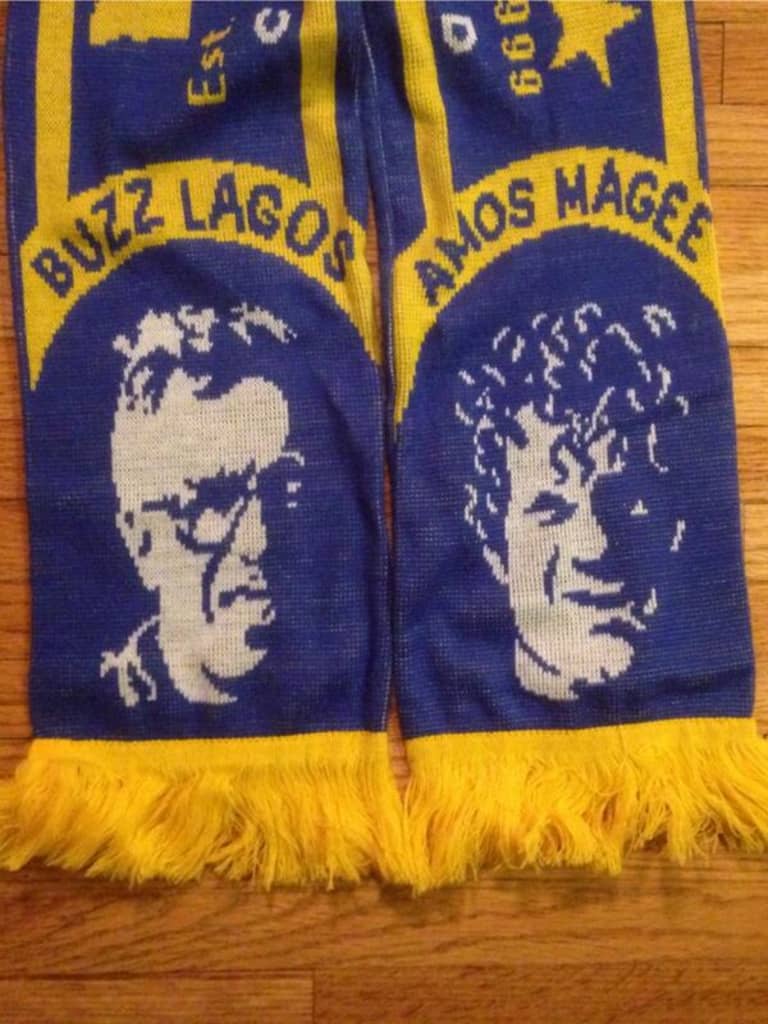At an English soccer match in 1930, the only jerseys you’d see were on the players. No one was going shirtless. No one was painting their face. The attire for the crowd hewed toward what we would today call “business”: slacks, collared shirts, ties, fedoras, overcoats. There was, however, one element of everyday dress that connects with a modern day soccer match: the scarf. In this brief clip from British Pathé of a West Ham match from that year, you can see the aftermath of a goal and a few supporters twirling their scarves in the air in a fashion no doubt familiar to anyone who’s been to an MNUFC match.
The kind of striped scarf seen here is a very early marker of fan support. Although the
Cambridge Rules
were established in 1848, it wasn’t until more than 20 years later that teams even began to wear consistent colors to distinguish the teams on the pitch from one another. As they did, though, teams started to develop identities around their colors, like Arsenal’s signature red and white kit from 1933 when a plain red long-sleeve shirt with white shorts was replaced by a much flashier (by the standards of the day) red kit with white sleeves and a white collar. Once these colors were established, they began to make their way in simple alternating patterns onto knit scarves.
In many ways, the scarf was simply sensible attire for a winter season sport in a northern climate. It kept you warm and the splash of color helped support your boys on the pitch. It was functional, and that fit the fans of the time well. Gradually, other elements were added to the scarves: club names, badges, more complicated color patterns. Eventually, scarves were made to commemorate specific matches and events. The soccer scarf had grown from a subtle adaptation of an everyday clothing item to a badge of honor or a memento of a moment.
And in America — where soccer the game is wildly popular but the rituals and traditions of the professional sport are unknown relative to those of most sports — the soccer scarf is a way to pledge allegiance and also stand out. No one thinks twice about someone in a Twins hat, but a soccer scarf — at least for the time being — is a little something different.
In Minnesota, fans have been wearing scarves for a long time — and maybe even longer than the clubs themselves have been making them. They take their scarves very seriously, as attested to by this post on the website The Loon Call that features photos of scarves for Minnesota’s pro soccer teams stretching back almost 15 years. The very first supporters scarf of what The Loon Call refers to as the “modern era” of soccer in Minnesota was made in 2004 for the Minnesota Thunder. It features Minnesota’s state motto (“L’etoile du nord”) and touts the Thunder’s 1999 A-League championship.


Two years later, the supporters scarf featured outgoing coach and godfather of Minnesota soccer Buzz Lagos (father of MNUFC Sporting Director Manny Lagos) and incoming coach Amos Magee (now the Director of Player Personnel for MNUFC). Magee — who had in 2003 retired after 11 years with the Thunder, including stints in MLS with the Tampa Bay Mutiny and Chicago Fire — was named to the USL Hall of Fame in 2008.
Like most of the best artifacts, scarves tell a story without really setting out to. This is doubly true with supporters scarves because they often reflect a certain zeitgeist that then feeds back into fandom itself. A 2011 scarf from the era of the Stars features the unmistakable outline of the Loch Ness Monster, a joke that comes into focus when you learn that the National Sports Center (NSC) was referred to affectionately as “Nessie.” A 2012 scarf proudly proclaims “Nuts of a Warrior” — a phrase uttered by Italian forward Simone Bracalello as the team prepared for the second leg of the 2011 NASL championship. They won, and it fed the story of the Stars’ underdog status. By the time Mexico’s U21 team came to play, the Stars had become MNUFC and the occasion called for a combined team scarf that had the state’s motto translated into Spanish (“Estrelle del norte”), touching back on that first scarf from 2004.
This is how the scarves enter into a kind of conversation with each other. The scarves in any fan’s closet all meant different things when they were bought, but meaning also rubs off on them over time, almost regardless of the design. When the team wins, maybe they wear that one over and over until the team loses. Those streaks have a weight, and every fan carrying their individual traditions into the stadium is all those weights combined into something thick and heavy — a foundation of belief. When that corner kick comes and you put your scarf up — whether it’s your first or your favorite or even your father’s, whether it’s the first or the hundredth or even the thousandth time — you’re adding, in your own small way, a line to the story.
Maybe that’s hokey. Scratch that: it’s totally hokey. But isn’t it that way with any kind of belief, any kind of story we tell ourselves? If there were evidence, if it made sense, it would be science. And let’s be honest: sports fandom is what we do against our better judgment, most of the time. Someone at a cold English pitch a hundred years ago had to be the first to take off his scarf and risk catching cold to twirl it above his head, after all.


